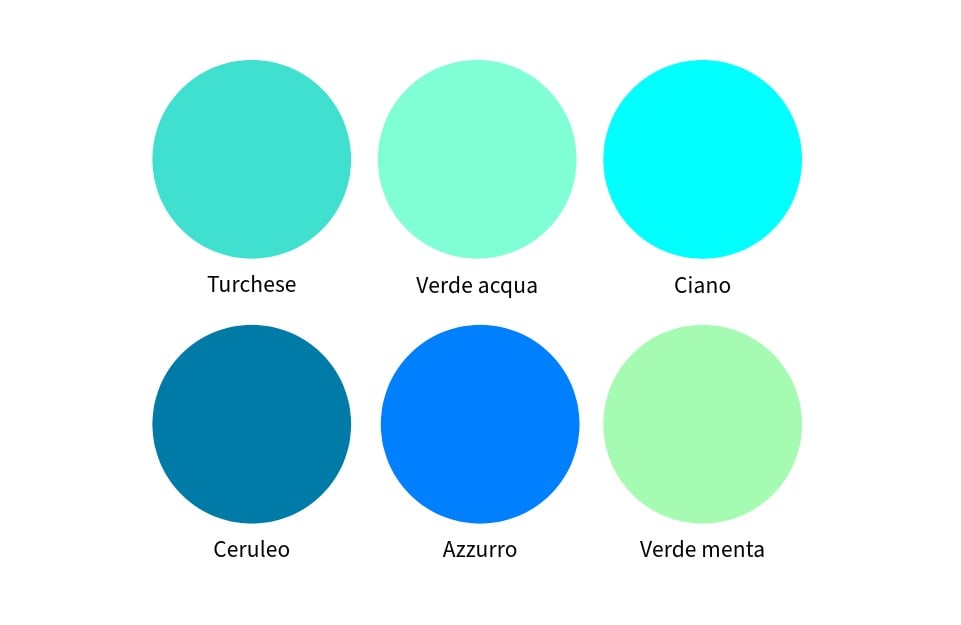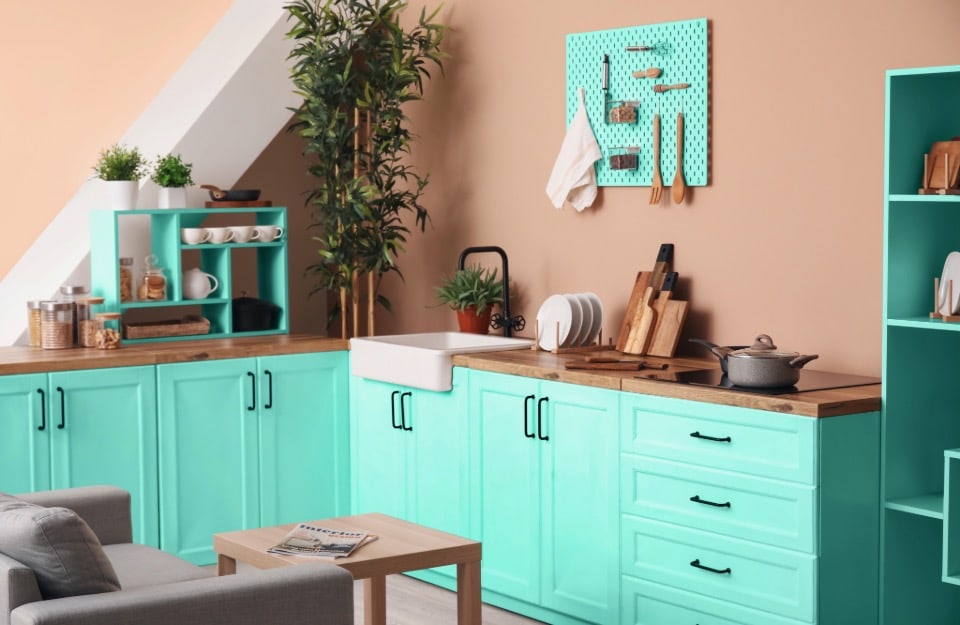Turquoise is a vibrant and versatile colour that can transform any home environment. Whether used for walls, furniture or small details, this colour is capable of transforming spaces, adapting to different aesthetic sensibilities. Let ‘s discover its characteristics and how to use it in interior design.
What colour is turquoise?

In the colour spectrum, turquoise lies between blue and green. It takes its name from thegemstone of the same name characterised by its typical blue-green colour. As a mineral, turquoise has been appreciated since antiquity for its beauty. On a symbolic level, it is considered the bearer of wisdom and good fortune.
The name turquoise derives from the French ‘turquoise’, i.e. ‘Turkish’, since in ancient times stones were imported to Europe from Turkey, although they came from what is now Iran and Afghanistan.
The term turquoise is also used in English.
How do you create turquoise with primary colours?

To obtain turquoise using the primary colours, it is necessary to mix blue (as the dominant base), a small amount of yellow (to lighten and achieve the greenish hue) and finally white (to further lighten and give brightness).
The proportion of blue to yellow is crucial: too much yellow tends to turn towards green, while too much blue brings the colour closer to cyan. There are different types of turquoise: proper turquoise, light turquoise, medium turquoise, dark turquoise and pale turquoise.
The differences with other types of green and blue

Turquoise is distinguished by its unique balance of blue and green. This is how it differs from other similar colours:
- teal: it is lighter and tends to be closer to green;
- cyan: is more saturated and with a more dominant blue component than turquoise;
- light blue: it is softer and lacks the greenish tinge that characterises turquoise;
- cerulean blue: has a more pronounced pure blue component and a delicate luminosity;
- mint green: it is lighter and with a dominant presence of green, making it fresher and more pastel.
With which styles of décor does turquoise work best?

Turquoise is extremely versatile and can be integrated into different furnishing styles.
- As a primary or secondary colour: in the coastal style, where it evokes marine atmospheres, combined with white, sand and light wood; in the ethnic style; in environments with a vintage flavour, used on lacquered furniture, sideboards or walls, in combination with retro motifs, dark wood and golden accessories.
- As a secondary colour: in rooms furnished in Scandinavian style; with Mediterranean style.
- Or as an accent colour: on almost any furnishing style, even the most minimalist. In particular: boho chic, shabby chic or Provençal, where it can be used on cushions, carpets or decorations, contrasting with warm shades such as orange or mustard yellow.
How to match turquoise walls

Turquoise walls can become the focal point of a room, but it is essential to match them correctly to avoid excess. Here are some combinations that are well suited to this hue:
- white: amplifies the brightness of turquoise, creating a fresh and airy effect. Perfect for bedrooms and bathrooms. In any case, a single turquoise wall can enhance any room, including the living room;
- Neutral tones: beige, light grey and dove grey dampen the energy of turquoise, making it more suitable for sophisticated spaces such as living rooms or studies;
- Vivid shades: burnt orange, yellow ochre, mustard or coral create dynamic contrasts, ideal for youthful and creative environments;
- natural wood: the combination with light or dark wood gives warmth and balances the liveliness of turquoise;
- some pastel colours: in the colour palette of Rio Verde’s Vintage Prestige line of paints, for example, we find several shades that go well with turquoise: milkshake pink, black cherry red, hazelnut, truffle and marzipan. These are highly opaque products that can be used on all surfaces (wood, metal, glass, plastic, fabric and small portions of wall) even without sanding.
How to match turquoise furniture

Turquoise furnishings can become protagonists or refined details, depending on how they are inserted:
- sofas and armchairs: a turquoise sofa in a living room is a style statement. it can be combined with cushions in neutral or complementary shades such as mustard or powder pink. For the walls: white, neutral shades or earthy colours;
- lacquered furniture: cupboards, coffee tables or sideboards in turquoise add a touch of colour in neutral rooms;
- fabrics: turquoise carpets, curtains or cushions can brighten up spaces dominated by more sober colours;
- accessories: turquoise vases, lamps or frames are perfect for giving accents of colour without distorting the ambience.


